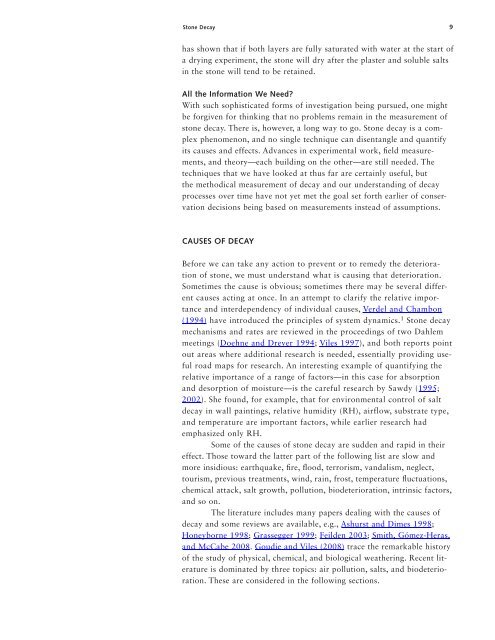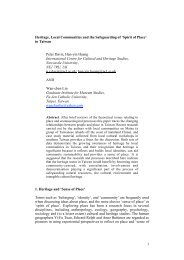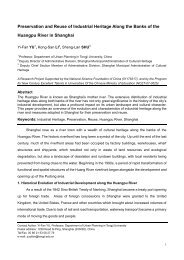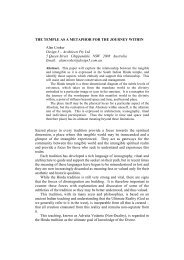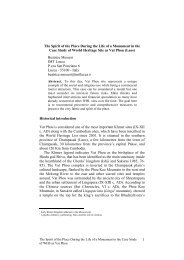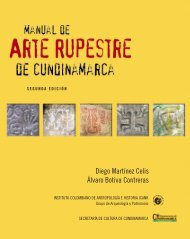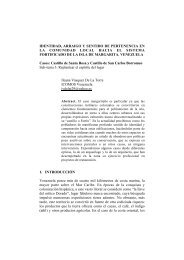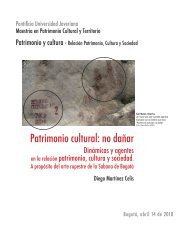<strong>Stone</strong> Decay 9has shown that if both layers are fully saturated with water at the start <strong>of</strong>a drying experiment, the stone will dry after the plaster and soluble saltsin the stone will tend to be retained.All the Information We Need?With such sophisticated forms <strong>of</strong> investigation being pursued, one mightbe forgiven for thinking that no problems remain in the measurement <strong>of</strong>stone decay. There is, however, a long way to go. <strong>Stone</strong> decay is a complexphenomenon, and no single technique can disentangle and quantifyits causes and effects. Advances in experimental work, field measurements,and theory—each building on the other—are still needed. Thetechniques that we have looked at thus far are certainly useful, butthe methodical measurement <strong>of</strong> decay and our understanding <strong>of</strong> decayprocesses over time have not yet met the goal set forth earlier <strong>of</strong> conservationdecisions being based on measurements instead <strong>of</strong> assumptions.CAUSES OF DECAYBefore we can take any action to prevent or to remedy the deterioration<strong>of</strong> stone, we must understand what is causing that deterioration.Sometimes the cause is obvious; sometimes there may be several differentcauses acting at once. In an attempt to clarify the relative importanceand interdependency <strong>of</strong> individual causes, Verdel and Chambon(1994) have introduced the principles <strong>of</strong> system dynamics. 1 <strong>Stone</strong> decaymechanisms and rates are reviewed in the proceedings <strong>of</strong> two Dahlemmeetings (Doehne and Drever 1994; Viles 1997), and both reports pointout areas where additional research is needed, essentially providing usefulroad maps for research. <strong>An</strong> interesting example <strong>of</strong> quantifying therelative importance <strong>of</strong> a range <strong>of</strong> factors—in this case for absorptionand desorption <strong>of</strong> moisture—is the careful research by Sawdy (1995;2002). She found, for example, that for environmental control <strong>of</strong> saltdecay in wall paintings, relative humidity (RH), airflow, substrate type,and temperature are important factors, while earlier research hademphasized only RH.Some <strong>of</strong> the causes <strong>of</strong> stone decay are sudden and rapid in theireffect. Those toward the latter part <strong>of</strong> the following list are slow andmore insidious: earthquake, fire, flood, terrorism, vandalism, neglect,tourism, previous treatments, wind, rain, frost, temperature fluctuations,chemical attack, salt growth, pollution, biodeterioration, intrinsic factors,and so on.The literature includes many papers dealing with the causes <strong>of</strong>decay and some reviews are available, e.g., Ashurst and Dimes 1998;Honeyborne 1998; Grassegger 1999; Feilden 2003; Smith, Gómez-Heras,and McCabe 2008. Goudie and Viles (2008) trace the remarkable history<strong>of</strong> the study <strong>of</strong> physical, chemical, and biological weathering. Recent literatureis dominated by three topics: air pollution, salts, and biodeterioration.These are considered in the following sections.
10 Chapter 1Air PollutionAir pollution is, to the minds <strong>of</strong> many, the prime culprit in stone decay.Everyone has heard <strong>of</strong> acid rain, and it is easy to conjure up an image<strong>of</strong> old buildings slowly dissolving in the rain. Needless to say, the truesituation is a good deal more complex, as reviews <strong>of</strong> the role <strong>of</strong> air pollutionand soiling in stone decay have found (Charola and Ware 2002;Mitchell and Searle 2004; Brimblecombe and Grossi 2007; Siegesmund,Snethlage, and Ruedrich 2008). The emphasis <strong>of</strong> these studies has largelybeen on limestone, marble, lime mortars, and carbonate-cementedsandstones, as these are the most vulnerable to acidic pollution. However,soiling from atmospheric particulates is a universal problem for all types<strong>of</strong> stone.Until recently, all the attention was given to the direct effects <strong>of</strong>air pollutants on stone, and research focused on the “traditional” pollutants:sulfur oxides, nitrogen oxides, and carbon dioxide. All are naturallyoccurring, although human activity has greatly increased the amountsthat are to be found in urban areas, as well as significantly increasingbackground levels <strong>of</strong> pollution in rural areas. All are capable <strong>of</strong> dissolvingin water to create an acidic solution and so are capable <strong>of</strong> reactingwith calcareous materials.The direct effects <strong>of</strong> air pollution on stone received enormousattention from the mid-1970s to the early 1990s. This is due, at least inpart, to concerns about the effects <strong>of</strong> pollution on health, agriculture, andthe environment. <strong>Stone</strong> research in Western Europe and the United Stateswas able to ride on the back <strong>of</strong> these concerns and to benefit from thefunding <strong>of</strong> large research programs. 2Since the early 1990s, priorities have shifted as progress hasbeen made in reducing sulfur dioxide (SO 2 ) levels in major metropolitanareas in Western Europe and the United States. Consequently, funds forresearch on air pollution on stone have steadily decreased and a number<strong>of</strong> larger programs have been discontinued altogether. Infrastructure andresearch groups, originally dependent on these large programs for thedevelopment <strong>of</strong> laboratories and funding for students, must now try tosurvive where there is no longer any state-supported program <strong>of</strong> research.Germany, for example, has had no federal support for stone conservationresearch since 1998.In spite <strong>of</strong> the funding decrease, several conferences over the pastdecade have addressed important open questions regarding the impact<strong>of</strong> air pollution on rates <strong>of</strong> stone soiling and decay. One grew out <strong>of</strong> aEC-funded project 3 (Saiz-Jimenez 2004). <strong>An</strong>other set <strong>of</strong> conferencesgrew out <strong>of</strong> SWAPNET (<strong>Stone</strong> Weathering and Atmospheric PollutionNetwork), a group <strong>of</strong> researchers focused on the topic <strong>of</strong> stone decayin polluted environments that started meeting at University CollegeLondon in the late 1980s. Since 1993 SWAPNET has held twelve meetings,mostly in the UK (Jones and Wakefield 1999; Mitchell and Searle2004; Smith and Warke 1996). The most recent SWAPNET meeting wasin Malta in 2007 (Gómez-Heras 2007), which reported progress in understandingthe rapid decay <strong>of</strong> certain stones affected by air pollution.
- Page 2 and 3: esearch in conservationThe Getty Co
- Page 4 and 5: Contentsvi Foreword to the Second E
- Page 6 and 7: ContentsvChapter 7 75 What Has Chan
- Page 8 and 9: Foreword to the Second Edition, 201
- Page 10: Preface to the Second Edition, 2010
- Page 13 and 14: Chapter Preface to # the First Edit
- Page 15 and 16: IntroductionAfter presenting his wo
- Page 18 and 19: Stone Decay 3ize terminology (Stone
- Page 20 and 21: Stone Decay 5.hpl.hp.com/news/2004/
- Page 22 and 23: Stone Decay 7ing the difficult chal
- Page 26 and 27: Stone Decay 11Damage to stone by ai
- Page 28 and 29: Stone Decay 13Some intriguing findi
- Page 30 and 31: Stone Decay 15crossing the deliques
- Page 32 and 33: Stone Decay 17pick up moisture from
- Page 34 and 35: Stone Decay 19by differences in the
- Page 36 and 37: Stone Decay 21Biological growths on
- Page 38 and 39: Stone Decay 23have appeared determi
- Page 40 and 41: Stone Decay 25Organic material in p
- Page 42 and 43: Chapter 2Putting It Right: Preventi
- Page 44 and 45: Stone Putting Decay It Right: Preve
- Page 46 and 47: Stone Putting Decay It Right: Preve
- Page 48 and 49: Stone Putting Decay It Right: Preve
- Page 50 and 51: Stone Putting Decay It Right: Preve
- Page 52 and 53: Stone Putting Decay It Right: Preve
- Page 54 and 55: Stone Putting Decay It Right: Preve
- Page 56 and 57: Stone Putting Decay It Right: Preve
- Page 58 and 59: Stone Putting Decay It Right: Preve
- Page 60 and 61: Stone Putting Decay It Right: Preve
- Page 62 and 63: Stone Putting Decay It Right: Preve
- Page 64 and 65: Chapter 3Do They Work? Assessing th
- Page 66 and 67: Stone Do They Decay Work? Assessing
- Page 68 and 69: Stone Do They Decay Work? Assessing
- Page 70 and 71: Stone Putting Decay It into Practic
- Page 72 and 73: Stone Putting Decay It into Practic
- Page 74 and 75:
Stone Heritage Decay in Stone: Rock
- Page 76 and 77:
Stone Heritage Decay in Stone: Rock
- Page 78 and 79:
Stone Heritage Decay in Stone: Rock
- Page 80 and 81:
Stone Heritage Decay in Stone: Rock
- Page 82 and 83:
Stone Doing Decay Better: Increasin
- Page 84 and 85:
Stone Doing Decay Better: Increasin
- Page 86 and 87:
Stone Doing Decay Better: Increasin
- Page 88 and 89:
Stone Doing Decay Better: Increasin
- Page 90 and 91:
Chapter # 7Chapter What Has Title C
- Page 92 and 93:
Stone What Has Decay Changed? Some
- Page 94 and 95:
Stone What Has Decay Changed? Some
- Page 96 and 97:
Chapter References #Chapter TitleAu
- Page 98 and 99:
References 83ed. D. Decrouez, J. Ch
- Page 100 and 101:
References 85Balboni, E., R. M. Esp
- Page 102 and 103:
References 87Bläuer, C., and A. Ku
- Page 104 and 105:
References 89carried out on Lecce s
- Page 106 and 107:
References 91Charola, A. E. 1995. W
- Page 108 and 109:
References 93Davis, K. J., and A. L
- Page 110 and 111:
References 95Doehne, E., and S. Pin
- Page 112 and 113:
References 97Facaoaru, I., and C. L
- Page 114 and 115:
References 99Buildings and Monument
- Page 116 and 117:
References 101Historia. http://www.
- Page 118 and 119:
References 103Poland, ed. J. W. Luk
- Page 120 and 121:
References 105the International RIL
- Page 122 and 123:
References 107Jurado, V., A. Fernan
- Page 124 and 125:
References 109Kumar, N., U. C. Kuls
- Page 126 and 127:
References 111“Conservation of St
- Page 128 and 129:
References 113Maravelaki-Kalaitzaki
- Page 130 and 131:
References 115Meinhardt-Degen, J.,
- Page 132 and 133:
References 117Mosch, S., and S. Sie
- Page 134 and 135:
References 119Paradise, T. R. 2002.
- Page 136 and 137:
References 121of porous stones: A u
- Page 138 and 139:
References 123Rodríguez-Navarro, C
- Page 140 and 141:
References 125Sawdy, A., A. Heritag
- Page 142 and 143:
References 127Siedel, H. 2008. Salt
- Page 144 and 145:
References 129Snethlage, R. 2005. L
- Page 146 and 147:
References 131the responsible and e
- Page 148 and 149:
References 133Vallet, J.-M., C. Gos
- Page 150 and 151:
References 135Viles, H. A., D. Camu
- Page 152 and 153:
References 137Whitley, D. S. 2005.
- Page 154 and 155:
References 139Zezza, F. 1990. Compu
- Page 156 and 157:
Appendix: Resources for Stone Conse
- Page 158 and 159:
Appendix: Resources for Stone Conse
- Page 160 and 161:
Appendix: Resources for Stone Conse
- Page 162 and 163:
Appendix: Resources for Stone Conse
- Page 164 and 165:
Appendix: Resources for Stone Conse
- Page 166 and 167:
Appendix: Resources for Stone Conse
- Page 168 and 169:
Index 153calcium hydroxide (slaked
- Page 170 and 171:
Index 155hexafluoropropene-vinylide
- Page 172 and 173:
Index 157research needed on, 55-56w
- Page 174 and 175:
About the AuthorsEric Doehne holds


